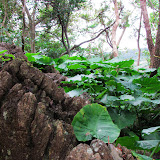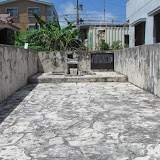 |
| A Lone Road on Kudaka Jima |
GPS
| Latitude | Longitude |
| N 26 09.816 | E 127 53.749 |
Kudaka-Jima
This is Kudaka Island, home of the first Okinawans as told by Okinawa folklore and tradition. But for all practical purposes, Kudaka Island looks no different than any other region in Okinawa. They have their farms, coral reefs, old style homes, dense vegetation, and structures of modern technology. However, there is one very noticeably difference about Kudaka-Jima once you set on foot. It is very eerily quiet.
Okinawan legends may vary, but one version originating around the beginning of the 16th Century tells us that two gods, Amamikyu and Shinerikyu, a female and male deity respectively, first descended on Kudaka Island many years ago. Still a virgin, Amamikyu had given birth to three children which became Okinawa's first inhabitants. The first child was a son and became the first king. The second was a daughter and became the first priestess or 'noro' and the third child was the second son and became the first farmer. Another account written around the 1650's tells us that Amamikyu and Shinerikyu descended from heaven and created the land and its inhabitants. Many years later, a grandson was born, named Tentenshi, and he divided mankind into five classes of people. He would bear five children and made the first son, the 'First Ruler', the second son, the 'First Noble (Anzu)', the third son, the 'First Farmer', the oldest daughter, the 'First High Priestess (Kikoe-ogimi)', and the second daughter, the 'First Village Priestess (Noro)'.
As you can see, the 'Noros' were well rooted in Okinawa folklore and history. The 'Noros' were at one time a powerful organization of women in the Ryukyu Kingdom. Their influence was immense. Highly regarded for advice, Ryukyu Kings would often seek them out for consultation. It was here at Kudaka-Jima, where a ceremony called the 'Izaiho' was held every 12 years to appoint a new Noro. The last one was conducted in 1978. In 1990 it was canceled due to declining population of women on Kudaka. It is not certain if such a historic ceremony will be revived again.
Enjoy the peace that comes with Kudaka. You may see many travelers there, particularly from mainland Japan. It is a great place to meditate and to soak in the spirituality of Okinawa. Included in the
photo album are numerous pictures of things you will see on Kudaka. Enjoy and have a safe journey.
Since there are soo many prayer sites on Kudaka, you may accidentally wander into a prayer session or ceremony. Please refrain from taking pictures unless given permission to do so and please maintain a proper distance. It might be wise to temporarily leave the area and come back later.
Souvenirs. Please refrain from taking any natural souvenirs (rocks, sand, etc.) from Kudaka Island. I know the temptation will be great. The gods will be watching. Strange things have happen to those who have tried...according to the O-Files ; )
Taking Pictures. Taking pictures is permissible all over the island except at Fubo Utaki. Please also avoid taking pictures of ceremonies unless given permission to do so. You may not even be allowed in the immediate premises during such event.
Fubo Utaki (Forbidden to the General Public). Eventually on the western side you will run into a sign that points you the entry way to Fubo Utaki, which is the most sacred place in all of Okinawa. Fubo Utaki and what really happens there is mired in mystery and will probably remain that way for a very long time. The entry point is marked by a sign written only in Japanese.
THE GENERAL PUBLIC ARE NOT ALLOWED PASSED THIS POINT. It is a small sign that has an arrow pointing to the ground. You can miss it. Look for these landmark signs (
picture 1 &
picture 2) of where you are not allowed to enter.
Getting Around Kudaka. I highly recommend renting a bike. The cost is inexpensive ranging from 300 Yen to 1000 Yen depending on how many hours you go for a ride. Kudaka Island is about 4km from tip to tip. You can walk to, but it will just take you a little longer and if there is a hot sun, you will be tired. See the
Travel Prep page for more info on what to bring.
Recommended Route. When you first get to Kudaka, I recommend you first start exploring the southern part of Kudaka which is the residential area of the island. You will see many prayer sites or 'utakis' in this area. Then make your way back to the port and start viewing the western side as you move your way up to the north. The west side of Kudaka has more interesting things to see such as wells/springs, landscape, and other prayer sites. Most of the wells are literally next to the rocky cliff. Halfway on the island the western and eastern routes converge to one central route that takes you to the northern most point on Kudaka. On your way back you can take the route on the eastern side. The eastern side is full of jagged coral reef and some beach areas. As you explore the western side, you may have to step off your bike and skirt part of the western edge on foot. If you strictly stay on the dirt road you may miss some of the wells and prayer sites. Most wells will be down close to sea level. There are about 4-5 of them on the western side. All have stairways that lead down to them. Please use caution. Some of the stairways are extremely damaged. There was one that was soo damaged due to harsh erosion that we decided not to go down on it. It literally seemed like it was on its last leg.
Source.
JapanTimes: Animistic Run Deep in Okinawa,
Okinawa Diaspora,
The Great Loochoo: A Study of Okinawa Village Life,
Pilgrimages and Spiritual Quest in Japan,
International Association of History of Religions:World Congress Proceedings Tokyo 2005 (PDF).
To learn how to travel to Kudaka, please refer to post:
Azama Port: Gateway to Kudaka.

























